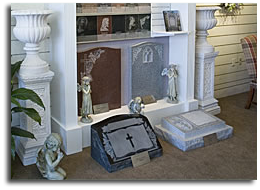Traditional Burial
Families turn to us to help them plan this important form of tribute because they have always found peace in services we provide, and confidence in the kindness we offer.
The Choice of Traditional Burial.

The time-honored rituals of traditional in-ground burial are an important step in the process of saying farewell, and healing from the sense of loss and bereavement. Families turn to us to help them plan this important form of tribute because they have always found peace in services we provide, and confidence in the kindness we offer.
When you choose traditional burial, there are commemorative choices appropriate for every family tradition, and every budget. These may include a memorial service, family gathering, services at the gravesite, and many others. When you enhance these services with “special touches” that personalize the funeral, you recall old memories, create new ones, deepen the meaning of the tribute, and help the healing process begin.
As we listen carefully to your wishes, we help you select from the many forms of tribute made possible by today’s contemporary funeral traditions. We welcome your questions and inquiries at any time.
Burial FAQ
What is opening and closing and why is it so expensive?
Opening and closing fees can include up to and beyond 50 separate services provided by the cemetery. Typically, the opening and closing fee include administration and permanent record keeping (determining ownership, obtaining permission and the completion of other documentation which may be required, entering the interment particulars in the interment register, maintaining all legal files); opening and closing the grave (locating the grave and laying out the boundaries, excavating and filling the interment space); installation and removal of the lowering device; placement and removal of artificial grass dressing and coco-matting at the grave site, leveling, tamping, re-grading and sodding the grave site and leveling and re-sodding the grave if the earth settles.
Can we dig our own grave to avoid the charge for opening and closing?
The actual opening and closing of the grave is just one component of the opening and closing fee. Due to safety issues which arise around the use of machinery on cemetery property and the protection of other gravesites, the actual opening and closing of the grave is conducted by cemetery grounds personnel only.
Why is having a place to visit so important?
To remember and to be remembered are natural human needs. A permanent memorial in a cemetery provides a focal point for remembrance and memorializing the deceased. Throughout human history, memorialization of the dead has been a key component of almost every culture. Psychologists say that remembrance practices, from the funeral or memorial service to permanent memorialization, serve an important emotional function for survivors by helping them bring closure and allowing the healing process to begin. Providing a permanent resting place for the deceased is a dignified treatment for a loved one’s mortal remains, which fulfills the natural human desire for memorialization.
What happens when a cemetery runs out of land?
When a cemetery runs out of land, it will continue to operate and serve the community. Most cemeteries have crematoriums, and some historic cemeteries even offer guided tours.
In a hundred years will this cemetery still be there?
We think of cemetery lands as being in perpetuity. There are cemeteries throughout the world that have been in existence for hundreds of years.
How soon after or how long after a death must an individual be buried?
There is no law that states a specific time from for burial. Considerations that will affect timeline include the need to secure all permits and authorizations, notification of family and friends, preparation of cemetery site and religious considerations. Public heath laws may have limitations on the maximum length of time allowed to pass prior to final disposition. Contact your local funeral provider for more details.
Does a body have to be embalmed before it is buried?
No. Embalming is a choice which depends on factors like if there is to be an open casket viewing of the body or if there is to be an extended time between death and internment. Public health laws may require embalming if the body is going to be transported by air or rail.
What options are available besides ground burial?
Besides ground burial, some cemeteries offer interment in lawn crypts or entombment in mausoleums. In addition, most cemeteries provide choices for those who have selected cremation. These often include placement of cremated remains in a niche of a columbarium or interment in an urn space.
What are burial vaults and grave liners?
These are the outside containers into which the casket is placed. Burial vaults are designed to protect the casket and may be made of a variety or combination of materials including concrete, stainless steel, galvanized steel, copper, bronze, plastic or fiberglass. A grave liner is a lightweight version of a vault which simply keeps the grave surface from sinking in.
Must I purchase a burial vault?
Most large, active cemeteries have regulations that require the use of a basic grave liner for maintenance and safety purposes. Either a grave liner or a burial vault will satisfy these requirements. Some smaller rural or churchyard cemeteries do not require use of a container to surround the casket in the grave.
There are alternatives to burial. See Cremation Services
 (718) 761-5544 |
(718) 761-5544 |  matthewfh@matthewfuneralhome.com |
matthewfh@matthewfuneralhome.com |  2508 Victory Boulevard, Staten Island, NY 10314
2508 Victory Boulevard, Staten Island, NY 10314







 matthewfh@matthewfuneralhome.com
matthewfh@matthewfuneralhome.com